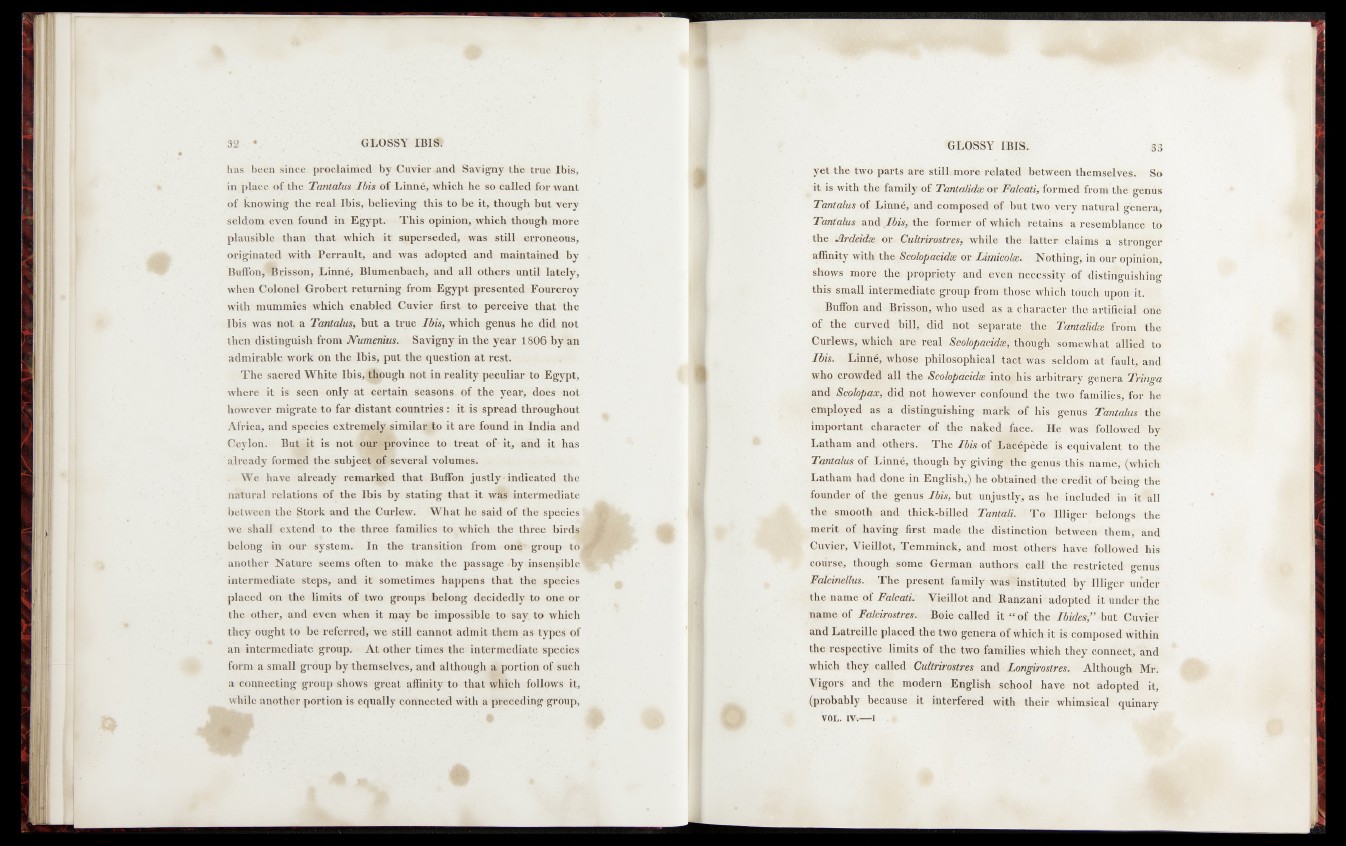
has been since, proclaimed byCuvier«and Savigny the true Ibis,
in, place of the Tantalus Ibis of Linné, which he so called for Want
of knowing the real- Ibis, believing this* to be it, though but very
seldbm even found in Egypt. This opinion, which though more
plausible than that which it' superseded, was still erroneous,
originated with Perrault, and was adopted and maintained by
Buffon,*risson, Linné, Blumenbach, and all others-until lately,
when Colonel Grobert returning from Egypt presented Fourcroy
with mummiés which enabled Cuvier first to perceive that the
Ibis, Was not a Tantalus, but a true Ibis, which genus he did not
then distinguish from Numerous. Savigny in the year 18Q6hy*hri
admirable work on the Ibis, put the question a t rest. .
The sacred White Ibis, jgbough not in reality peculiar to Egypt,
where it is seen only at certain seasons, of the year, does-napt-
however migrate to far distant countries : it is spread throughout
Africa* and species extremely similar to it are fcpnd in India and
Seylom* Butait is noti 6 gK |o y in c e to treat of’ it, ahd it has
already fomip. the subjec^p^feveral volumes.
. We have already reinarljged that Buffon justly * indicated the
natural relations of the Ibis by stating that it w w intermediate
between the ^tork and the Curlew. What he said of the speciesl
we shall extend to the' three families to,, which the three birdaj
belong in our system. In the transition from onê* group toj
another Nature seems often to- make the passage -by insensible’
intermediate ; steps, and it sometimes happens that the species
placed on the limits, of two groups .belong decidedly to one or
the other, and even when it may he impossible to Say, to which
they ought to be referred, we still cannot admit them .as types of
an intermediate group. At other times the intermediate species
form a small group by themselves, and although a. portion of such
a conneeting group* shows great affinity to that which follows it,
whipe another portion is equally ebspiected with a preceding group,
yet th® two parts are stilLmore related ^between themselves. So
o it is with th&fsm^^MTantalidæ of Falmii,{ovmed from the genus
Tantalus of? Linné,-’ aaid composed* ©if but twepvery natural genera,
Tantalus and Ibis, the former of which'-retains a> resemblance t'o
the Jlrdeidæ or. Cultrivostres, while« the'* latte®' 'claims a "stronger
affinity with the* Ècohpacidæ or Aimieôlæ. | Nothing, in our-opinion,
shows more- thci -propFiefy and even necessity • of distinguishing
this small i nter-mediafe.group fromi*hos!e||vhidhttonchl-jupdb i t.< '1
Buffon and Bris^ôüf,f'who'* used J?as a charaStér Èhe artifiefalt eMe
oUSb* curved bill, . not
Curlews, which are ifeaiL Scölopaeidk^Mough llipi^what allied to
Ibis. LinnJ^whose philosbphioal^ïacWas-' sêlà^în: at faultj^nd
who crowded all the Scohpdcidæ int^hist arbitrary gen'era^^hoa
and Scolopax,- dldynot however confound the-.two families^för -fee
employed as a distinguishing malrk o f hi^geüus ;Wantqlus' the
important character of the nakedjace.- He was IfeJlowedT'hy
Latham and others. The Ibis, of ’*3fN|?épèdedis equivalent to'the
Tdntalus of Linné, though by givij^plie gemi^'tybufame,- |#hi'ch
Latham had done in English*,) he ohÿaawndttfee'obEeèit-of being the
founder of the genus Ibis, but' unjustly, a® he-mcltfded^in’falill
the smpoth and thick-billed TantkK. belongs the
merit of having first ma.de the diminution between" them, htti
Cuvier, Vieillot, Temminck, and most others^ have followed his
eburse, though sème German authors, call*' the lehtrieted? genus
Falcinellus. The present family wa^nstiiuted by Illig ^ -tifnder
the name of Falcati: '■ Vieillot and Ram-zanr adopted ittender* the
name of Falcirestres. Boie called- « «of the Ibides,” -but Guvifer
and Latreille plapecbthe two genera of Whieh it.ds-c’ömposed 'vvithin
the respective limits of the two-^milies-wbich they conne’et}!* and
which they/called Cultrimtres and Aongfrostres. Although Mr.
Vigors and the modern English school haVe not adopteÉ it,
^probably because it interfered /wlfh their whimsical quinary
VOL. iv »——i- ,<